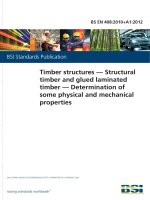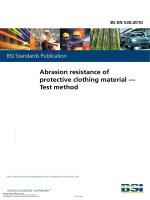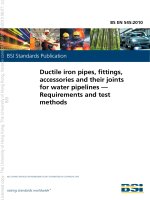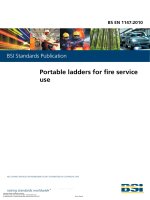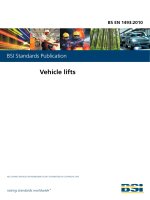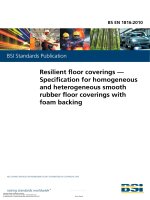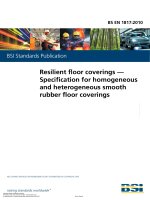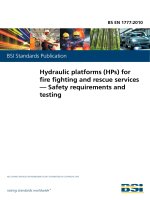Bsi bs en 50104 2010
Bạn đang xem bản rút gọn của tài liệu. Xem và tải ngay bản đầy đủ của tài liệu tại đây (951.89 KB, 34 trang )
BS EN 50104:2010
BSI Standards Publication
Electrical apparatus for the
detection and measurement
of oxygen — Performance
requirements and test methods
BS EN 50104:2010
BRITISH STANDARD
National foreword
This British Standard is the UK implementation of EN 50104:2010. It
supersedes BS EN 50104:2002 which is withdrawn.
The UK participation in its preparation was entrusted to Technical
Committee GEL/31/19, Gas detectors.
A list of organizations represented on this committee can be
obtained on request to its secretary.
This publication does not purport to include all the necessary
provisions of a contract. Users are responsible for its correct
application.
© BSI 2011
ISBN 978 0 580 71925 7
ICS 13.320; 29.260.20
Compliance with a British Standard cannot confer immunity from
legal obligations.
This British Standard was published under the authority of the
Standards Policy and Strategy Committee on 28 February 2011.
Amendments issued since publication
Date
Text affected
BS EN 50104:2010
EUROPEAN STANDARD
EN 50104
NORME EUROPÉENNE
June 2010
EUROPÄISCHE NORM
ICS 13.320
Supersedes EN 50104:2002 + A1:2004
English version
Electrical apparatus for the detection and measurement of oxygen Performance requirements and test methods
Appareils électriques de détection
et de mesure de l'oxygène Règles de performance et méthodes
d'essai
Elektrische Geräte für die Detektion
und Messung von Sauerstoff Anforderungen an das Betriebsverhalten
und Prüfverfahren
This European Standard was approved by CENELEC on 2010-06-01. CENELEC members are bound to
comply with the CEN/CENELEC Internal Regulations which stipulate the conditions for giving this European
Standard the status of a national standard without any alteration.
Up-to-date lists and bibliographical references concerning such national standards may be obtained on
application to the Central Secretariat or to any CENELEC member.
This European Standard exists in three official versions (English, French, German). A version in any other
language made by translation under the responsibility of a CENELEC member into its own language and
notified to the Central Secretariat has the same status as the official versions.
CENELEC members are the national electrotechnical committees of Austria, Belgium, Bulgaria, Croatia,
Cyprus, the Czech Republic, Denmark, Estonia, Finland, France, Germany, Greece, Hungary, Iceland,
Ireland, Italy, Latvia, Lithuania, Luxembourg, Malta, the Netherlands, Norway, Poland, Portugal, Romania,
Slovakia, Slovenia, Spain, Sweden, Switzerland and the United Kingdom.
CENELEC
European Committee for Electrotechnical Standardization
Comité Européen de Normalisation Electrotechnique
Europäisches Komitee für Elektrotechnische Normung
Management Centre: Avenue Marnix 17, B - 1000 Brussels
© 2010 CENELEC
-
All rights of exploitation in any form and by any means reserved worldwide for CENELEC members.
Ref. No. EN 50104:2010 E
BS EN 50104:2010
EN 50104:2010
–2–
Foreword
This European Standard was prepared by SC 31-9, Electrical apparatus for the detection and
measurement of combustible gases to be used in industrial and commercial potentially explosive
atmospheres, of Technical Committee CENELEC TC 31, Electrical apparatus for potentially explosive
atmospheres, on the basis of EN 50104:2002. It was submitted to the Unique Acceptance Procedure and
approved by CENELEC as EN 50271 on 2010-06-01.
This document supersedes EN 50104:2002 + A1:2004.
Attention is drawn to the possibility that some of the elements of this document may be the subject of
patent rights. CEN and CENELEC shall not be held responsible for identifying any or all such patent rights.
The following dates were fixed:
–
–
latest date by which the EN has to be implemented
at national level by publication of an identical
national standard or by endorsement
(dop)
2011-06-01
latest date by which the national standards conflicting
with the EN have to be withdrawn
(dow)
2013-06-01
This European Standard has been prepared under a mandate given to CENELEC by the European
Commission and the European Free Trade Association and covers essential requirements of EC Directive
94/9/EC. See Annex ZZ.
The State of the Art is included in Annex ZY “Significant changes between this European Standard and
EN 50104:2002”.
__________
BS EN 50104:2010
–3–
EN 50104:2010
Contents
Contents ................................................................................................................................ 3
1
Scope ............................................................................................................................ 4
2
Normative references ................................................................................................... 4
3
Definitions .................................................................................................................... 5
4
5
3.1
Gas properties ...................................................................................................... 5
3.2
Types of apparatus ............................................................................................... 5
3.3
Sensors ................................................................................................................ 6
3.4
Supply of gas to apparatus .................................................................................... 7
3.5
Signals and alarms ............................................................................................... 7
3.6
Times ................................................................................................................... 7
General requirements .................................................................................................. 8
4.1
Introduction ........................................................................................................... 8
4.2
Construction ......................................................................................................... 8
4.3
Labelling and marking ......................................................................................... 10
4.4
Instruction manual .............................................................................................. 10
Test methods ............................................................................................................. 12
5.1
Introduction ......................................................................................................... 12
5.2
General requirements for tests ............................................................................ 12
5.3
Normal conditions for test ................................................................................... 13
5.4
Test methods and performance requirements ...................................................... 15
Annex A (informative) Sequence of tests ............................................................................ 27
Annex ZY (informative) Significant changes between this European Standard
and EN 50104:2002 ...............................................................................................................................28
Annex ZZ (informative) Coverage of Essential Requirements of EC Directives ................ 29
Figure
Figure 1 - Warm-up time in reference air or in zero test gas (typical) ..................................... 26
BS EN 50104:2010
EN 50104:2010
–4–
1 Scope
This European Standard specifies general requirements for construction, testing and performance, and
describes the test methods that apply to portable, transportable and fixed apparatus for the measurement
of the oxygen concentration in gas mixtures indicating up to 25 % (v/v). The apparatus, or parts thereof,
may be intended for use in potentially explosive atmospheres (see 4.1) and in mines susceptible to
firedamp.
In the case of inert gas purging (inertization), it applies also to apparatus with an oxygen measuring
function for explosion protection.
NOTE
Commonly used oxygen sensors in commercial equipment for industrial application are:
a) paramagnetic sensors;
b) electrochemical sensors (aqueous and solid electrolytes);
c) tunable diode laser absorption spectroscopy sensors (TDLAS).
This standard is also applicable when an apparatus manufacturer makes any claims regarding any special
features of construction or superior performance that exceed the minimum requirements of this standard.
All such claims shall be verified and the test procedures shall be extended or supplemented, where
necessary, to verify the claimed performance. The additional tests shall be agreed between the
manufacturer and test laboratory and identified and described in the test report.
This European Standard is applicable to oxygen alarm apparatus intended to measure reliably the oxygen
concentration, to provide an indication, alarm or other output function, the purpose of which is to give a
warning of a potential hazard and, in some cases, to initiate automatic or manual protective action(s),
whenever the level exceeds or falls below a preselected alarm concentration.
This standard is applicable to apparatus, including integral sampling systems of aspirated apparatus,
intended to be used for commercial, industrial and non-residential safety applications.
This standard does not apply to external sampling systems, or to apparatus of laboratory or scientific type,
or to medical equipment, or to apparatus used only for process control purposes. For apparatus used for
sensing the presence of multiple gases, this standard applies only to the measurement of oxygen.
This standard is also applicable to apparatus using optical principles (e.g. TDLAS), where the optical
transmitter and receiver or the optical transceiver (i.e. combined transmitter and receiver) and a suitable
reflector are not located in a common enclosure. However, in this case it will be necessary to modify the
test conditions described in Clause 5 and to introduce supplementary tests to Clause 6 of this standard.
Such supplementary tests will include alignment, beam block fault, long range operation. Guidance to
appropriate modification of the test conditions and supplementary tests may be taken from
EN 60079-29-4. Modifications of the test conditions as well as modified and supplementary tests shall be
agreed between the manufacturer and test laboratory and identified and described in the test report.
2 Normative references
The following referenced documents are indispensable for the application of this document. For dated
references, only the edition cited applies. For undated references, the latest edition of the referenced
document (including any amendments) applies.
EN 50270
Electromagnetic compatibility - Electrical apparatus for the detection and
measurement of combustible gases, toxic gases or oxygen
EN 50271
Electrical apparatus for the detection and measurement of combustible
gases, toxic gases or oxygen - Requirements and tests for apparatus using
software and/or digital technologies
EN 60079-0
Explosive atmospheres - Part 0: Equipment - General requirements
(IEC 60079-0)
EN 60079-29-4
Explosive atmospheres - Part 29-4: Gas detectors - Performance
requirements of open path detectors for flammable gases (IEC 60079-29-4)
BS EN 50104:2010
–5–
EN 50104:2010
3 Definitions
For the purposes of this document, the following terms and definitions apply.
3.1
Gas properties
3.1.1
ambient air
normal atmosphere surrounding the apparatus
3.1.2
poisons (for sensors)
substances which lead to temporary or permanent loss of sensitivity of the sensors
3.1.3
reference air
air, under normal ambient conditions, with an oxygen concentration of (21 ± 0,4) % (v/v)
3.1.4
standard test gas
test gas with a composition specified for each apparatus to be used for all tests unless otherwise stated
(see 5.3.2)
3.1.5
volume fraction (v/v)
quotient of the volume of a specified component and the sum of the volumes of all components of a gas
mixture before mixing, all volumes referring to the pressure and the temperature of the gas mixture
NOTE
The volume fraction and volume concentration take the same value if, at the same state conditions, the sum of the
component volumes before mixing and the volume of the mixture are equal. However, because the mixing of two or more gases at
the same state conditions is usually accompanied by a slight contraction or, less frequently, a slight expansion, this is not generally
the case.
3.1.6
zero test gas
gas, such as nitrogen, which is free of oxygen, and interfering and contaminating substances
3.2
Types of apparatus
3.2.1
alarm-only apparatus
apparatus having an alarm but not having a meter or other indicating device
3.2.2
aspirated apparatus
apparatus that samples the gas by drawing it to the gas sensor, for example, by means of a handoperated or electric pump
3.2.3
automatically aspirated apparatus
aspirated apparatus with an integral pump
3.2.4
continuous duty apparatus
apparatus that is powered for long periods of time, but may have either continuous or intermittent sensing
3.2.5
diffusion apparatus
apparatus in which the transfer of gas from the atmosphere to the gas sensor takes place by random
molecular movement, i.e. under conditions in which there is not aspirated flow
BS EN 50104:2010
EN 50104:2010
–6–
3.2.6
fixed apparatus
apparatus that is intended to have all parts permanently installed
3.2.7
portable apparatus
apparatus that has been designed to be carried readily from place to place and to be used while it is being
carried. A portable apparatus is battery powered and includes, but is not limited to
a) a hand-held apparatus, typically less than 1 kg, suitable for one-handed operation without accessories
(such as sampling probes, sample lines) fitted,
b) personal monitors, similar in size and mass to the hand-held apparatus, that are continuously operating
(but not necessarily continuously sensing) while they are attached to the user, and
c) another apparatus that can be operated by the user while it is carried either by hand, by a shoulder
strap or carrying harness, and which may or may not have a hand-directed probe
3.2.8
spot-reading apparatus
apparatus intended to be used for short, intermittent or irregular periods of time as required (typically
5 min or less)
3.2.9
transportable apparatus
apparatus not intended to be portable, but which can be readily moved from one place to another
3.2.10
stand-alone gas detection apparatus
fixed gas detection apparatus that provide a conditioned electronic signal or output indication to a
generally accepted industry standard (such as 4-20 mA), intended to be utilized with stand-alone control
units, or signal processing data acquisition, central monitoring and similar systems which typically process
information from various locations and sources including, but not limited to, gas detection apparatus
3.2.11
stand-alone control unit
fixed gas detection control units intended to provide meter indication, alarm functions, output contacts
and/or alarm signal outputs when utilized with stand-alone gas detection apparatus
3.3
Sensors
3.3.1
integral sensor
sensor which is integral to the main body of the apparatus
3.3.2
measuring principle
type of physical or physico-chemical detection principle and the measurement procedure to determine the
measured value
3.3.3
remote sensor
sensor which is not integral to the main body of the apparatus
3.3.4
sensing element
part of the sensor which directly picks up the quantity to be measured and which is sensitive to that
quantity
BS EN 50104:2010
–7–
EN 50104:2010
3.3.5
sensor
assembly in which the sensing element is housed and which may also contain associated circuit
components
3.4
Supply of gas to apparatus
3.4.1
sample line
a means by which the gas being sampled is conveyed to the sensor including accessories, e.g. filter,
water trap
3.4.2
sampling probe
separate sample line which is attached to the apparatus as required, that may or may not be supplied with
the apparatus. It is usually short (e.g. in the order of 1 m) and rigid (although it may be telescopic), but it
may be connected by a flexible tube to the apparatus
3.5
Signals and alarms
3.5.1
alarm set point
fixed or adjustable setting of the apparatus that is intended to pre-set the level of concentration at which
the apparatus will automatically initiate an indication, alarm or other output function
3.5.2
fault signal
audible, visible or other type of output, different from the alarm signal, permitting, directly or indirectly, a
warning or indication that the apparatus is not working satisfactorily
3.5.3
latching alarm
alarm that, once activated, requires deliberate action to be deactivated
3.5.4
repeatability
closeness of agreement between the results of successive measurements of the same value of the same
quantity carried out by the same method, with the same measuring instruments, by the same observer, in
the same laboratory at quite short intervals of time in unchanged conditions
3.6
Times
3.6.1
drift
variation in the apparatus indication with time, at any fixed gas volume fraction under constant ambient
conditions
3.6.2
final indication
indication given by the apparatus after stabilisation
3.6.3
stabilisation
state when three successive readings of an apparatus, taken at 2 min intervals, indicate no changes
greater than ± 1 % of the measuring range
BS EN 50104:2010
EN 50104:2010
–8–
3.6.4
time of response tx (not applicable to spot-reading apparatus)
time interval, with the apparatus in a warmed-up condition, between the time when an instantaneous
variation in volume fraction is produced at the apparatus inlet and the time when the response reaches a
stated percentage (x) of the difference between the initial and the final indication
3.6.5
minimum time to operate (spot-reading apparatus)
time interval between the initiation of a measurement procedure and the time when the apparatus
indication reaches a stated percentage of the final indication
3.6.6
warm-up time (not applicable to spot-reading apparatus)
time interval, with the apparatus in a stated atmosphere, between the time when the apparatus is switched
on and the time when the indication reaches and remains within the stated tolerances (see Figure 1)
4 General requirements
4.1
Introduction
The apparatus shall comply with the requirements of this standard.
Electrical assemblies and components shall comply with the construction and test requirements of 4.2,
where applicable. In addition, parts of the gas detection apparatus intended for use in potentially explosive
atmospheres shall employ materials, and comply with the construction and explosion protection as
specified in the appropriate regulations for explosion protection.
4.2
4.2.1
Construction
General
Gas detection apparatus or parts thereof (e.g. remote sensors) specifically intended for use in the
presence of corrosive vapours or gases shall be constructed of materials known to be resistant to
corrosion by such substances.
All apparatus shall be constructed to facilitate regular accuracy checks.
All materials and components used in the construction of the apparatus shall be used within the
manufacture’s ratings or limitations unless otherwise specified by appropriate safety standards.
4.2.2
Indicating devices
An indication shall be provided to show that the apparatus is energised.
NOTE The indication may be shown at the control unit.
For alarm-only apparatus or apparatus where the resolution of the read-out device is inadequate to
demonstrate compliance with this standard, the manufacturer shall identify suitable points for connecting
additional indicating or recording devices for the purpose of testing the compliance of the apparatus with
this standard. The indication on the read-out device of the apparatus shall not contradict the results
obtained by the additional indicating or recording devices.
Any under-range or over-range measurements shall be clearly indicated.
If the apparatus has more than one measuring range, the range selected shall be clearly identified.
BS EN 50104:2010
–9–
EN 50104:2010
If only one indicating light is provided for signalling alarms, faults and other indications, it shall be coloured
red. If separate indicating lights are used or if a multi-coloured indicating light is provided, the colours shall
be used in the following order of priority ((a) being highest priority):
a) alarms indicating the presence of gas at potentially dangerous levels shall be coloured RED;
b) equipment fault indicators shall be coloured YELLOW;
c) power supply indicators shall be coloured GREEN.
In addition to the colour requirements, the indicator lights shall be adequately labelled to show their
functions.
4.2.3
Alarm or output functions
Alarm devices shall not be adjustable to operate outside the measuring range.
If alarm devices, output contacts or alarm signal outputs are provided as part of fixed or continuous duty
portable apparatus and are intended to operate when a potentially hazardous gas concentration is
detected, they shall be of a latching type requiring a deliberate manual action to reset. If two or more
alarm set points having the same direction (activation at increasing or decreasing oxygen concentration,
respectively) are provided, the first alarm may be non-latching - based on user preference.
NOTE 1 The latching device may reside in software.
Alarms shall remain in operation while the alarm condition is still present. An additional audible alarm may
be silenced.
NOTE 2 This implies that it may not be possible to switch off the apparatus if an alarm condition is present.
If it is possible to de-activate alarm devices, output contacts or alarm signal outputs, e.g. for calibration
purposes, this deactivation shall be indicated by a signal. For fixed apparatus, this shall include a contact
or other transmittable output signal. Alternatively, the output signal or contacts are not required if the
alarms are automatically re-enabled within 15 min.
4.2.4
Fault signal
Fixed and transportable apparatus shall provide a fault signal in the event of failure of power to the
apparatus. A short circuit or open circuit in connections to any remote sensor shall be indicated by a fault
signal.
Automatically aspirated apparatus shall be provided
a) in the case of fixed and transportable apparatus: with an integral flow-indicating device that produces a
fault signal in the event of flow failure,
b) in the case of portable apparatus: with a means of verifying the air flow.
4.2.5
Adjustments
All adjustment devices shall be designed so as to discourage unauthorised or inadvertent interference with
the apparatus. Examples would include procedural devices, in the case of a keyboard instrument, or
mechanical devices such as a cover requiring the use of a tool.
Fixed explosion-protected apparatus housed in explosion-protected enclosures shall be designed so that,
if any facilities for adjustments are necessary for routine recalibration and for resetting or like functions,
these facilities shall be externally accessible. The means for making adjustments shall not degrade the
explosion protection of the apparatus.
The adjustments of the zero and signal amplification shall be so designed that adjustments of one will not
affect the other.
BS EN 50104:2010
EN 50104:2010
4.2.6
– 10 –
Battery-powered apparatus
Apparatus powered with integral batteries shall be provided with an indication of low battery condition, and
the nature and purpose of this indication shall be explained in the manual.
4.2.7
Stand-alone gas detection apparatus for use with separate control units
A specification shall be supplied with the apparatus that describes the relationship the gas concentration
(detected by the apparatus) has with the corresponding output signal or indication (transfer function). Such
specification shall be detailed to the extent that the accuracy of this transfer function can be verified. As a
minimum, the manufacturer shall provide data showing the relationship between the output signal and the
gas concentrations corresponding to 0,10 %, 25 %, 50 %, 75 % and 100 % of full-scale output indication.
Full-scale output and status signals (e.g. fault, inhibit) shall also be specified by the manufacturer.
Where necessary, equipment shall be provided by the manufacturer to interpret the output signal or
indication, which will enable the accuracy of the transfer function to be verified.
4.2.8
Separate control units for use with stand-alone gas detection apparatus
A specification shall be supplied with the apparatus that describes the relationship the input signal has
with the calculated gas concentration (transfer function). Such specification shall be detailed to the extent
that the accuracy of this transfer function can be verified. As a minimum, the manufacturer shall provide
data showing the relationship between the input signal and the gas concentrations corresponding to
0,10 %, 25 %, 50 %, 75 % and 100 % of full-scale indication. Required inputs for full-scale indication and
status signals (e.g. fault, inhibit) shall also be specified by the manufacturer.
Where necessary, equipment shall be provided by the manufacturer to provide the input signals, which will
enable the accuracy of the transfer function to be verified.
4.2.9
Apparatus using software and/or digital technologies
The apparatus shall fulfil the requirements of EN 50271.
4.3
Labelling and marking
The apparatus shall be marked legibly and indelibly. The following minimum requirements apply:
a) name and address of the manufacturer;
b) certification marking;
c) designation of series or type;
d) serial number, if any;
e) year of construction (may be encoded within the serial number);
f) “EN 50104” (to represent conformance with this performance standard). If due to size constraints this
information cannot be put onto the apparatus, it shall be included in the instruction manual;
g) If applicable, the apparatus shall comply with the additional marking requirements of EN 60079-0.
4.4
Instruction manual
Each apparatus shall be provided with an instruction manual that includes the following information:
a) complete instructions, drawings and diagrams for safe and proper operation, installation and servicing
of the apparatus;
b) adjustment procedures;
c) recommendations for initial checking and calibration of the apparatus on a routine basis, including
procedures and time intervals
NOTE Users are referred to EN 60079-29-2.
d) instructions for the use of the field verification kit including sample flow rate limits, if provided;
BS EN 50104:2010
– 11 –
EN 50104:2010
e) details of operational limitations including, where applicable, the following:
1)
intended use (oxygen deficiency, oxygen enrichment, inertization);
2)
whether the apparatus is intended to be used in potentially explosive atmospheres;
3)
measuring principles and description of the apparatus functions;
4)
time of response t90;
5)
temperature limits;
6)
humidity limits;
7)
pressure limits;
8)
supply voltage limits;
9)
maximum power consumption;
10) relevant characteristics and construction details of required interconnecting cables;
11) for battery operated apparatus, battery type(s) and operating time(s) until low battery condition;
12) nominal orientation and orientation limits;
13) safety-related significance of the measuring sequence in non-continuous operation and
possibilities of adapting the measuring sequence to the monitoring tasks;
14) warm-up time;
15) stabilisation time;
16) gas mixtures expressly prohibited by the manufacturer;
f) details of storage life and limitations for the apparatus, replacement parts and accessories, including,
where applicable, the following limits:
1)
temperature;
2)
humidity;
3)
pressure;
4)
time;
g) information on the adverse effects of poisons and interfering gases or substances on the proper
performance (and, in the case of oxygen-enriched atmospheres, on electrical safety) of the apparatus;
h) for aspirated apparatus, indication of the minimum and maximum flow rates and pressure, or,
for automatically aspirated apparatus, indication of the nominal flow rate and the flow rate where the
flow failure signal is set or, if adjustable, the range of flow rates where the flow failure signal can be set;
i) for aspirated apparatus, tubing type, maximum length and size for proper operation;
j) for aspirated apparatus, instructions for ensuring that the sample lines are intact and that proper flow is
established (see 4.2.4);
k) statements of the nature and significance of all alarms and fault signals, the duration of such alarms
and signals (if time-limited or non-latching), and any provisions that may be made for silencing or
resetting such alarms and signals, as applicable;
l) details of any method for the determination of the possible sources of a malfunction and any corrective
procedures (i.e. trouble-shooting procedures);
m) a statement that alarm devices, outputs or contacts are of the non-latching types, where applicable
(see 4.2.3);
n) for battery-operated apparatus, installation and maintenance instructions for the batteries;
o) if applicable, instructions for replacement of the sensor;
p) a recommended replacement parts list;
q) where optional accessories (e.g. collecting cones, weather-protecting devices) are supplied, the
manufacturer shall list such accessories and state their effects on the apparatus characteristics
(including time of response and sensitivity), and provide means for their identification (e.g. part
numbers included in manual);
r) details of certification and marking, and any special conditions of service;
s) where the special nature of the apparatus (such as non-linear responses) requires additional
instructions or special information that are alternative to, or in addition to, the requirements of 4.3 and
4.4 a) to r), the instructions or information shall be provided.
BS EN 50104:2010
EN 50104:2010
– 12 –
5 Test methods
5.1
Introduction
The test methods and procedures described in 5.2 to 5.4 are intended as a basis for establishing whether
the apparatus conforms with the performance requirements given in this draft European Standard.
This standard is also applicable when an apparatus manufacturer makes any claims regarding any special
features of construction or superior performance that exceed the minimum requirements of this standard.
This may be increased accuracy or performance within the limits of the standard, or performance beyond
the specifications of the standard. All such claims, including environmental claims, shall be verified and
the test procedures shall be extended or supplemented, where necessary, to verify the claimed
performance. The additional tests shall be agreed between the manufacturer and test laboratory and
identified and described in the test report.
When claiming a superior performance outside these specifications, the measurement accuracy is not
required to meet the standard’s minimum requirements when outside this specification (e.g. for the normal
temperature range of -10 °C to +40 °C the accuracy shall be ± 5 % of the measuring range, but an
extended temperature range of -25 °C to -10 °C may have a wider tolerance, such as ± 10 % of the
measuring range).
5.2
General requirements for tests
5.2.1
5.2.1.1
Samples and sequence of tests
General
For the purpose of type testing, the tests shall be carried out on one apparatus. Another apparatus may be
used for the tests according to 5.4.4 and 5.4.23.
5.2.1.2
Sequence
The apparatus shall be subjected to all of the tests applicable to that type of apparatus, as described in
5.4. Test 5.4.2 shall be conducted prior to all other tests. The manufacturer may request a particular order
of the other tests. The sequence of tests used during type testing shall be recorded. A recommended
sequence is given in Annex A.
5.2.1.3
Stand alone gas detection apparatus
Stand alone gas detection apparatus shall be tested to the requirements of 5.4.2 through 5.4.16, 5.4.19
through 5.4.25 (if applicable) using the parameters of the transfer function.
5.2.1.4
Stand alone control units
Stand alone control units shall be tested to the requirements of 5.4.2, 5.4.3, 5.4.4, 5.4.6, 5.4.7, 5.4.13,
5.4.15, 5.4.16, 5.4.19, 5.4.20 and 5.4.25 using the parameters of the transfer function pertinent to the
specific type of gas detector.
5.2.1.5
Test of compliance with General Requirements
Tests shall also be carried out, where applicable, to ensure that the apparatus satisfies the construction
requirements of 4.2. The requirements for these tests are generally self-evident, except that for shortcircuit requirements in 4.2.4, ballast resistors shall be substituted for each wire connecting the control unit
to any remote sensor. The values of these resistors shall be those declared, in the instruction manual, to
be the maximum lead resistances allowing satisfactory compliance with this European Standard. The
device used for the short circuit shall be of negligible resistance and shall be applied to convenient points
in the circuit, at the sensor ends of the ballast resistors.
BS EN 50104:2010
– 13 –
5.2.1.6
EN 50104:2010
Apparatus with selectable range
For apparatus having more than one selectable range or scale, each range shall be tested. For the
second and subsequent ranges, the necessary amount of testing shall be agreed upon between the
manufacturer and the test laboratory.
5.2.2
Preparation of apparatus before testing
The apparatus shall be prepared and mounted as near to typical service as possible, in accordance with
the instruction manual, including all necessary interconnections, initial adjustments and initial calibrations.
Adjustments may be made, where appropriate, at the beginning of each test.
In particular, the following points shall be noted:
a) Apparatus having remote sensors
For the purpose of the tests in 5.4, where reference is made to exposure of the sensor to the test
conditions, the entire remote sensor (including any or all normally attached protective mechanical
parts) shall be exposed.
For apparatus having connection facilities for more than one remote sensor, only one remote sensor
needs to be subjected to the tests. The replacement of all but one sensor by „dummy“ impedances
yielding the worst case load conditions for the test in question shall be permitted. The worst case load
conditions shall be determined by the testing laboratory within the limits specified in the instruction
manual.
For apparatus having remote sensor(s), all tests shall be performed with resistances connected in the
detector circuit to simulate the maximum line resistance specified by the apparatus manufacturer,
except where minimum line resistance offers a more stringent test in the judgement of the test
laboratory.
b) Apparatus having integral sensors
The entire apparatus shall be exposed to the test conditions without removal of any normally attached
parts, including any sampling probe for tests 5.4.11, 5.4.15, 5.4.16 and 5.4.17.
c) For alarm-only apparatus, readings shall be taken using an external indicating or recording device
connected to test points described in 4.2.2.
In all cases, optional parts shall be either attached or removed according to which condition will give the
most unfavourable result (at the discretion of the testing laboratory) for the test being conducted.
5.2.3
Mask for calibration and test
When a mask is used for calibration or for the injection of test gas into the sensor, the design and
operation of the mask used by the testing laboratory, in particular the pressure and velocity inside the
mask, shall not inadmissibly influence the response of the apparatus or the results obtained.
NOTE It is recommended that the testing laboratory should consult with the manufacturer in determining the design of the
calibration mask. The manufacturer may provide with the apparatus a suitable calibration mask together with details of suggested
pressure and flow rate for application of calibration gases to the apparatus.
5.3
5.3.1
Normal conditions for test
General
The test conditions specified in 5.3.2 to 5.3.11 shall be used for all tests, unless otherwise stated.
BS EN 50104:2010
EN 50104:2010
5.3.2
– 14 –
Test gas(es)
The volume fraction of oxygen in the standard test gas shall fall in the middle of the measuring range as
defined by the manufacturer, whereas the upper limit of the measuring range shall be not greater than
25 % (v/v).
The tolerance on the nominal volume fraction of the standard test gas shall be within ± 0,5 % (v/v) of
oxygen or ± 10 % of the concentration of the standard test gas, whichever is less.
When the apparatus is intended for measuring oxygen deficiency or enrichment, all tests shall be made
with reference air and standard test gas.
When the apparatus is intended for measuring inertization, all tests shall be made with zero test gas and
standard test gas. For apparatus with a lower limit of the measuring range above zero, a test gas with the
oxygen concentration at the lower limit of the measuring range shall be used instead of zero test gas.
When the apparatus is intended for more than one application, it shall be tested for each application.
The volume fractions of the test gases shall be known to a relative expanded uncertainty of ± 2 %.
NOTE The gas mixture may be prepared by any suitable method.
5.3.3
Flow rate for test gases
When the apparatus is exposed to the test gases, the flow rate of the gas shall be in accordance with the
manufacturer’s instructions.
NOTE For an apparatus that samples by diffusion, either a calibration mask in accordance with 5.2.3 or a test chamber may be
used.
5.3.4
Power supply
a) Fixed AC or DC powered apparatus shall be operated within 2 % of the manufacturer’s recommended
supply voltage and frequency.
b) Battery-powered apparatus shall, for short-term tests, be equipped with new or fully charged batteries
at the commencement of each series of tests. For long-term testing, it is permissible to energise the
unit from a stabilised power supply.
5.3.5
Temperature
The ambient air and test gas shall be held at a constant temperature ± 2 K within the range of 15 °C to
25 °C, throughout the duration of each test.
5.3.6
Pressure
The tests shall be performed at pressures between 86 kPa and 108 kPa, with a maximum variation of
± 1 kPa throughout the duration of each short-term test. For long-term tests, the influence of pressure
changes shall be taken into account, using the results of the pressure test (5.4.8).
5.3.7
Humidity
The relative humidity (r.h.) of the ambient air and the standard test gas shall be controlled to within
± 10 % r.h. over the range 20 % to 80 % r.h. throughout each test.
For short applications of test gases, the use of dry gases is permitted if agreed between the manufacturer
and the test laboratory. The properties of the sensor shall be taken into account, e.g. drying out.
BS EN 50104:2010
– 15 –
5.3.8
EN 50104:2010
Stabilisation time
In each instance where the apparatus is subjected to a different test condition, the apparatus shall be
allowed to stabilise under these new conditions before measurements are taken.
5.3.9
Orientation
The apparatus shall be tested in the orientation recommended by the manufacturer.
5.3.10 Communications options
For apparatus having wired or wireless communications options used during normal gas detection
operation, tests in 5.4.3, 5.4.7 and 5.4.16 shall be performed with all communication ports connected. The
maximum transaction rate, cabling characteristics and activity level specified by the manufacturer shall be
employed.
5.3.11 Gas detection systems
For gas detection systems, tests in 5.4.3, 5.4.7, 5.4.16 and 5.4.19 shall be performed with the maximum
system communications transaction rate and activity level. This shall correspond to the largest and most
complex system configuration permitted by the manufacturer.
5.4
Test methods and performance requirements
5.4.1
General
The following tests shall be performed in accordance with 5.3, unless otherwise stated. All tests shall be
performed.
At the end of each test, indications shall be taken in both reference air or zero test gas and in the standard
test gas, unless otherwise stated. The values of the indications used for verification of compliance with the
performance requirements shall be the final indications (see 3.6.2) of both the reference air or zero test
gas and the standard test gas readings, unless otherwise stated.
5.4.2
Unpowered storage
All parts of the apparatus shall be exposed sequentially to the following conditions in reference air only:
a) a temperature of - 20 °C ± 3 °C for 24 h;
b) ambient temperature for at least 24 h;
c) a temperature of 40 °C ± 2 °C for 24 h;
d) ambient temperature for at least 24 h.
At each temperature, the humidity of the clean air shall be so that condensation does not occur.
The above temperatures may be varied only after an agreement has been reached between the
manufacturer and testing laboratory. Where temperatures other than those listed above are used, they
shall be listed in the test report.
Performance requirements: After being submitted to the conditions specified above, the apparatus shall
meet the requirements specified in 5.4.3 to 5.4.26.
5.4.3
5.4.3.1
Calibration, adjustment and repeatability
Initial preparation of the apparatus
The apparatus shall be calibrated and adjustments shall be carried out, if needed, to obtain correct
indications in accordance with the manufacturer’s instruction manual.
BS EN 50104:2010
EN 50104:2010
5.4.3.2
– 16 –
Calibration curve
The apparatus shall be exposed to four test gases, two of which shall have an oxygen volume fraction at
the lower limit of the measuring range (e.g. zero test gas for apparatus intended for measuring
inertization) and a volume fraction near to the upper limit of the measuring range respectively. The test
gas volume fractions shall be evenly distributed over the measuring range. The gas with the lowest
volume fraction shall be applied first in the sequence, followed by the other test gases in order of
increasing volume fraction. The application of the first three gases shall be repeated in the reverse order,
i.e. in order of decreasing volume fraction, ending with the lowest volume fraction.
This operation shall be carried out three times consecutively, giving four measured values for the gas with
the lowest oxygen volume fraction, three at the highest volume fraction, and six at each of the
intermediate volume fractions.
Performance requirements: Each individual indication in the three sets of indications obtained for each of
the four gas volume fractions shall not differ from these volume fractions by more than ± 0,2 % (v/v) of
oxygen or ± 2,5 % of the measuring range, whichever is the greater.
5.4.3.3
Repeatability
Expose the apparatus to either zero test gas or reference air, and then to standard test gas and record the
measurement in each case. The duration of the application of the test gases shall be three times the time
of response t90 of the apparatus for concentration rise or concentration drop. Repeat this cycle nine more
times.
Performance requirement: The standard deviation of the values shown at the end of the gas application
shall be smaller than ± 0,1 % (v/v) of oxygen or ± 1 % of the measuring range, whichever is the greater.
5.4.4
Stability (continuous duty apparatus only)
NOTE For these tests, battery-powered apparatus should be powered from internal batteries wherever possible, otherwise an
external power supply may be used.
5.4.4.1
Fixed and transportable apparatus
The apparatus shall be operated continuously in reference air (apparatus intended for measuring oxygen
deficiency or enrichment) or in zero test gas (apparatus intended for measuring inertization) for a period of
two months. At the end of every week, the apparatus shall be exposed to standard test gas, until
stabilised. Indications shall be taken prior to both the application and removal of the standard test gas.
Performance requirement: The variation of the indications under either zero test gas or reference air and
under standard test gas as determined by linear regression shall not exceed ± 5 % of the measuring
range or ± 0,4 % (v/v) oxygen per two months, whichever is the greater.
5.4.4.2
Portable apparatus
The apparatus shall be operated continuously in reference air (apparatus intended for measuring oxygen
deficiency or enrichment) or in zero test gas (apparatus intended for measuring inertization) for a period of
8 h per working day over a total of 20 working days. In the remaining time, the apparatus shall be switched
off and exposed to ambient air. At the end of every 5 working days, the apparatus shall be exposed to
zero test gas or reference air, and standard test gas, until stabilised. Indications shall be taken prior to
both the application and removal of each gas.
Performance requirement: The variation of the indications under either zero test gas or reference air and
under standard test gas as determined by linear regression shall not exceed ± 2,5 % of the measuring
range or ± 0,2 % (v/v) oxygen per 20 working days, whichever is the greater.
BS EN 50104:2010
– 17 –
5.4.5
EN 50104:2010
Stability (spot-reading apparatus only)
The apparatus shall be exposed to standard test gas for 1 min followed by either zero test gas or
reference air for 1 min. The operation shall be repeated 200 times. Indications shall be taken prior to both
the application and removal of each gas.
NOTE For this test, battery-powered apparatus should be powered from internal batteries wherever possible, otherwise an external
power supply may be used.
Performance requirement: The variation of the indications under either zero test gas or reference air and
under standard test gas shall not be more than ± 2,5 % of the measuring range or ± 0,2 % (v/v) of oxygen,
whichever is the greater.
5.4.6
5.4.6.1
Alarm set point(s)
General
When the apparatus is provided with either
a) externally adjustable means of setting either one or more alarm set points, or
b) internally pre-set alarm point(s),
the activation of such alarms by gas at the appropriate set point values shall be verified by using test
gases as described in 5.4.6.2 up to 5.4.6.5. In all cases, the test gas shall be applied until either activation
of the alarm(s) or twice the respective t90, whichever is less.
For apparatus with several alarm set points, these tests shall be carried out for each alarm set point.
If a latching alarm is provided, the latching and the manual reset action shall be checked.
The selected alarm set points shall not change when the measuring range is changed.
5.4.6.2
Increasing oxygen concentration (apparatus intended for measuring oxygen deficiency
or enrichment)
For apparatus of type a), set the alarm set point at 10 % relative below the volume fraction of the
reference air. If the alarm set point cannot be set at this concentration the alarm shall be set as near as
possible to that concentration. In this case and for apparatus of type b), the test gas shall have a volume
fraction of 10 % relative above the concentration of the alarm set point.
Expose the apparatus to standard test gas, and then to reference air or the specified test gas above.
Performance requirement: The alarm shall activate following application of the reference air or the
specified test gas.
5.4.6.3
Increasing oxygen concentration (apparatus intended for measuring inertization)
For apparatus of type a), set the alarm set point at 10 % relative below the volume fraction of the standard
test gas. If the alarm set point cannot be set at this concentration, the alarm shall be set as near as
possible to that concentration. In this case and for apparatus of type b), the test gas shall have a volume
fraction of 10 % relative above the concentration of the alarm set point.
Expose the apparatus to zero test gas, and then to standard test gas or the specified test gas above.
Performance requirement: The alarm shall activate following application of the standard test gas or the
specified test gas.
BS EN 50104:2010
EN 50104:2010
5.4.6.4
– 18 –
Decreasing oxygen concentration (apparatus intended for measuring oxygen deficiency
or enrichment)
For apparatus of type a), set the alarm set point at 10 % relative above the volume fraction of the standard
test gas. If the alarm set point cannot be set at this concentration, the alarm shall be set as near as
possible to that concentration. In this case and for apparatus of type b), the test gas shall have a volume
fraction of 10 % relative below the concentration of the alarm set point.
Expose the apparatus to reference air, and then to standard test gas or the specified test gas above.
Performance requirement: The alarm shall activate following application of the standard test gas or the
specified test gas.
5.4.6.5
Decreasing oxygen concentration (apparatus intended for measuring inertization)
For apparatus of type a), set the alarm set point at 10 % of the measuring range. If the alarm set point
cannot be set at this concentration, the alarm shall be set as near as possible to that concentration. In this
case and for apparatus of type b), the test gas shall have a volume fraction of 10 % relative below the
concentration of the alarm set point.
Expose the apparatus to standard test gas, and then to zero test gas or the specified test gas above.
Performance requirement: The alarm shall activate following application of the zero test gas or the
specified test gas.
5.4.7
Temperature
This test shall be performed in a temperature chamber having the capability of holding the sensor or
apparatus at the specified temperature within ± 2 °C. When the apparatus (or the portion under test) has
reached the specified temperature, the sensor shall be exposed sequentially to zero test gas or reference
air, and then standard test gas, which shall be at the same temperature as the atmosphere in the test
chamber. The dew point of the test gases shall be below the lowest temperature of the test chamber and
kept constant during the test.
Tests shall be carried out:
-
For control units:
at temperatures of 5 °C, 20 °C and 55 °C;
-
For remote sensors and all types of apparatus with integral sensors:
at temperatures of - 10 °C, 20 °C and 40 °C.
Performance requirement: For control units, the variation of the indications from that at 20 °C in zero test
gas or reference air, and standard test gas shall not exceed ± 3 % of the measuring range. For all other
types of apparatus, the variation of the indications from that at 20 °C in zero test gas or reference air, and
standard test gas shall not exceed ± 5 % of the measuring range or ± 0,5 % (v/v) of oxygen, whichever is
the greater.
5.4.8
Pressure
The effects of pressure variation shall be observed by placing the sensor or apparatus (including the
aspirator for aspirated apparatus) in a test chamber that permits the pressure of the test gases to be
varied. The pressure shall be maintained at the specified levels for 5 min, before a reading is accepted or
a test is made.
Tests shall be carried out at pressures of 80 kPa, 100 kPa and 120 kPa.
NOTE The pressure should be changed with a rate less than 10 kPa/h.
